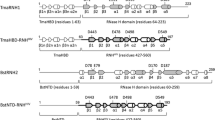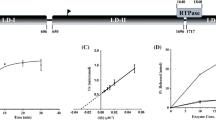Summary
The reverse transcriptase/RNase H of HIV-1 is composed of a p66/p51 heterodimer when analyzed from virus particles. A recombinant reverse transcriptase (RT)/RNase H which after purification consisted mainly of p66 was analyzed as substrate of the purified recombinant HIV-1 protease p9 in vitro. The p66 protein if treated with the protease is processed to a stable p66/p51 heterodimer. A p15 protein is a prominent cleavage product which was identified as the carboxyterminal portion of p66 by means of a monoclonal antibody. It exhibits RNase H activity when tested by activated gel analysis. Presence of SDS during the incubation allowed complete degradation of p66 depending on the conditions, which indicates that conformation of a substrate is relevant for cleavage by the HIV-1 protease. A synthetic heptapeptide AET-FYVD derived from the region between RT and RNase H is cleaved efficiently in vitro by the HIV-1 protease at the F'Y junction, and may mimick a natural cleavage site. P66/p51 heterodimers exhibit higher RT and RNase H activities than p66 when renatured from polyacrylamide gels.
Similar content being viewed by others
References
Barr PJ, Power MD, Lee-Ng CT, Gibson HL, Luciw PA (1987) Expression of active HIV-reverse transcriptase inSaccharomyces cerevisiae. Biotechnology 5: 486–489
Billich S, Knoop MT, Hansen J, Strop P, Sedlacek J, Mertz R, Moelling K (1988) Synthetic peptides as substrates and inhibitors of human immune deficiency virus-1 protease. J Biol Chem 263: 17905–17908
Cleveland DW, Fischer SG, Kirchner MW, Laemmli UK (1977) Peptide mapping by limited proteolysis in SDS and analysis by gel electrophoresis. J Biol Chem 252: 1102–1106
Di Marzo Veronese F, Copeland TD, DeVico AL, Rahman R, Orozlan S, Gallo RC, Sarngadharan MG (1986) Characterization of highly immunogenic p66/p51 as the reverse transcriptase of HTLV-III/LAV. Science 231: 1281–1291
Farmerie WG, Loeb DH, Casavant NC, Hutchinson III CA, Edgell MH, Swanstrom R (1987) Expression and processing of the AIDS-virus reverse transcriptase inE. coli. Science 263: 305–308
Hager DA, Burgess RR (1980) Elution of proteins from sodium dodecyl sulfate-polyacrylamide gels, removal of sodium dodecyl sulfate, and renaturation of enzymatic activity: results with sigma subunit ofEscherichia coli RNA polymerase, wheat germ DNA topoisomerase, and other enzymes. Anal Biochem 109: 76–86
Hansen J, Schulze T, Moelling K (1987) RNase H activity associated with bacterially expressed reverse transcriptase of human T-cell lymphotropic virus III/lymphadenopathy-associated virus. J Biol Chem 262: 12393–12396
Hansen J, Billich S, Schulze T, Sukrow S, Moelling K (1988) Partial purification and substrate analysis of bacterially expressed HIV protease by means of monoclonal antibody. EMBO J 7: 1785–1791
Hansen J, Schulze T, Mellert W, Moelling K (1988) Identification and characterization of HIV-specific RNase H by monoclonal antibody. EMBO J 7: 239–243
Huet J, Sentenac A, Fromageot P (1978) Detection of nucleases degrading double-helical RNA and of nucleic acid binding proteins following SDS-gel electrophoresis. FEBS Lett 94: 28–32
Johnson MS, McClure MA, Feng DF, Gray J, Doolittle RF (1986) Computer analysis of retroviral pol-genes: assignment of enzymatic functions to specific sequences and homologies with non-viral enzymes. Proc Natl Acad Sci USA 83: 7648–7652
Kanaya S, Kohara A, Miyagawa M, Matsuzaki T, Mori-Kawa K, Ikehara M (1989) Overproduction and preliminary crystallographic study of ribonuclease H fromE. coli. J Biol Chem 20: 11546–11549
Larder B, Purifoy D, Powell K, Darby G (1987) AIDS virus reverse transcriptase defined by high level expression inE. coli. EMBO J 6: 3133–3137
Le Grice SFJ, Beuck V, Mous J (1987) Expression of biologically active HTLV-III reverse transcriptase inBacillus subtilis. Gene 55: 95–103
Lightfoote MM, Coligan JE, Folks TM, Fanci AS, Martin MA, Venkatesan S (1986) Structural characterization of reverse transcriptase and endonuclease polypeptides of the AIDS retrovirus. J Virol 60: 771–775
Lori F, Scovassi AI, Zella R, Achilli G, Cattaneo E, Casoli C, Bertazzoni U (1988) Enzymatically active forms of reverse transcriptase of HIV. AIDS Res Human Retroviruses 4: 393–398
Lowe DM, Aitken A, Bradley C, Darby GK, Larder BA, Powell KL, Purifoy DJM, Tisdale M, Stammers DK (1988) HIV-1 reverse transcriptase: crystallization and analysis of domain structure by limited proteolysis. Biochemistry 27: 8884–8889
Moelling K (1974) Reverse transcriptase and RNase H: present in a murine virus and in both subunits of an avian virus. Cold Spring Harbor Symp Quant Biol 39: 969–973
Moelling K (1974) Characterization of reverse transcriptase and RNase H from Friend-murine leukemia virus. Virology 62: 46–59
Moelling K, Schulze T, Knoop MT, Kay J, Jupp R, Nicolaou G, Pearl LH (1990) In vitro inhibition of HIV-1 proteinase by cerulenin. FEBS Lett 261: 373–377
Prasad VR, Goff SP (1989) Linker insertion mutagenesis of the HIV reverse transcriptase expressed in bacteria: definition of the minimal polymerase domain. Proc Natl Acad Sci USA 86: 3104–3108
Ratner L, Haseltine W, Patarca R, Livak KJ, Starcich B, Josephs SF, Doran ER, Rafalski JA, Whitehorn EA, Baumeister K, Ivanoff L, Petteway SR, Pearson ML, Lautenberger JA, Papas TS, Ghrayeb J, Chang NT, Gallo RC, Wong-Staal F (1985) Complete nucleotide sequence of the AIDS virus, HTLV-III. Nature 313: 227–284
Remaut E, Stanssen RM, Friers U (1981) Plasmid vectors for high efficiency expression controlled by the PL promotor of coliphage lambda. Gene 15: 81–93
Spanos A, Huebscher U (1983) Recovery of functional proteins in SDS gels. Methods Enzymol 91: 263–277
Spanos A, Sedgwick SG, Yarranton GT, Huebscher U, Banks GR (1981) Detection of the autocatalytic activities of DNA polymerases and their associated exonucleases following SDS-polyacrylamide gel electrophoresis. Nucleic Acids Res 9: 1825–1835
Tanese N, Prasad VR, Goff SP (1988) Structural requirements for bacterial expression of stable, enzymatically active fusion proteins containing the HIV reverse transcriptase. DNA 7: 407–416
Author information
Authors and Affiliations
Rights and permissions
About this article
Cite this article
Schulze, T., Nawrath, M. & Moelling, K. Cleavage of the HIV-1 p66 reverse transcriptase/RNase H by the p9 protease in vitro generates active p15 RNase H. Archives of Virology 118, 179–188 (1991). https://doi.org/10.1007/BF01314028
Received:
Accepted:
Issue Date:
DOI: https://doi.org/10.1007/BF01314028




